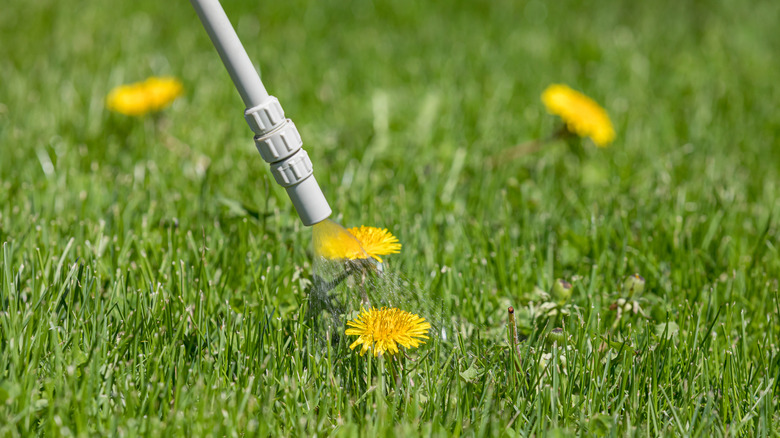Natural Options For Killing Dandelions Without Hurting Your Grass
While some homeowners value dandelions (Taraxacum officinale) for their citrusy, slightly tart flavor, medicinal potential, and bright yellow appearance, others consider them an unattractive, annoying weed. The compound found most commonly in commercial herbicides, glyphosate, is generally considered unsafe for humans and the environment, though it is still available in the United States. Fortunately, there are organic treatments, like spraying young weeds with vinegar and pulling by hand, that take using chemicals out of the equation. Pulling by hand may be the best method to not disturb the surrounding grass. Spraying directly with vinegar can be effective, but vinegar works on contact rather than working its way through the plant's system into the roots. Therefore, it can also burn back or kill the surrounding grass. To prevent hurting your grass, apply vinegar only to the dandelions, and use caution.
Preventing dandelions from growing in your lawn in the first place can diminish the need to spray or hand pull them. A well-maintained, healthy lawn is your best natural defense against dandelions. To keep your lawn healthy, follow the recommended irrigation guidelines for your region, let your grass grow to 3 to 4 inches in height, mow about the top quarter inch off your turf once a week, and fertilize according to the package instructions. Simply mowing or deadheading dandelions is not an effective weed control method. While these methods stop seeds from spreading, the plant's taproots grow deep into the soil, and new dandelions will emerge from any bit of root left behind.
Use vinegar with caution
Spraying young dandelions with acetic acid, commonly known as vinegar, has proven to be effective. Concentrations of 10% to 20%, or higher, of acetic acid (known as horticultural vinegar) produce the best results. Commonly used in DIY cleaning solutions, household vinegar is typically in the 5% range and is only marginally effective on very young dandelions. Spray undiluted, high-concentration commercial vinegar directly on the plants, taking care not to spray the surrounding grass.
Treat the plants using a sprayer with a large, flat nozzle to saturate all of the leaves. Because acetic acid works on contact, it must be reapplied as new growth appears. Apply the vinegar on a hot, sunny day in late fall, the best time of year to treat dandelions, when there's no rain in the immediate forecast. Using a commercial vinegar that contains a surfactant like yucca extract may improve its effectiveness. The leaves of the dandelion plant will start to die back within hours, and any overspray on the soil will likely break down within a few days. However, it could also change the pH levels in the soil or harm beneficial pollinators, so use with caution.
Strong acetic acid can burn the skin and irritate the eyes. On direct contact, it can damage the eye's cornea permanently and burn your throat and mouth if ingested. Inhaling the vapor can damage the lungs. Read the product warning label and wear protective gear including goggles and a mask when you're spraying dandelions. Avoid treating your yard for dandelions on windy days for your own safety and to minimize the chance of spraying the grass around the weeds.
Digging up dandelions by the roots
While spraying stops seeds from spreading, dandelion taproots grow deep into the soil, and new weeds will emerge from any bit of root left behind. To control the plants without using any chemicals while also protecting your surrounding grass, you must dig out as much of the root as possible and continue to dig the roots out as weeds reappear aboveground over time. This is the safest option and may also be the most effective, but it requires some work.
The best time to remove the taproots is when the dandelion is young and the soil is damp. Special tools designed for this task exist — smaller options won't disturb the surrounding soil as much as larger tools. If you don't have a specific tool, dig out the plant, taking care not to cut the thick taproot. Slide a sturdy digging stick or the handle of a tool like a shovel or hoe under the root and apply downward pressure to pull it aboveground. Pull as much of the root out of the ground as possible to prevent it from growing back. If you discover that the tap roots are shallow, you may be dealing with a dandelion look-alike like sow thistle.


